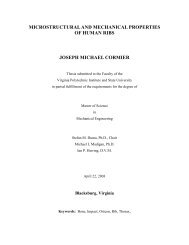Research Articles - VTechWorks - Virginia Tech
Research Articles - VTechWorks - Virginia Tech
Research Articles - VTechWorks - Virginia Tech
Create successful ePaper yourself
Turn your PDF publications into a flip-book with our unique Google optimized e-Paper software.
Featured <strong>Articles</strong><br />
Cooperstein<br />
the Appalachian and European subcultures<br />
intersect.<br />
Women were often believed to have a spiritual<br />
connection with the divine. This is<br />
seen in the longstanding tradition of midwifery.<br />
Midwives were a necessity, even<br />
as cultures gradually became more modernized.<br />
Consequently, they were able to<br />
maintain an “old world” perspective. The<br />
importance of their vocation empowered<br />
them to carry on the positive aspects of the<br />
old cultures. This perception of midwifery<br />
changed over time, and is evidenced by the<br />
stories and superstitions that still reside in<br />
those areas.<br />
Cooperstein’s interest in the Divine Feminine<br />
began in a class on Arthurian legend<br />
taught by philosophy professor, Dr. Joseph<br />
Pitt. She studied women in literature and<br />
found facts about real women that related<br />
to her research. She also found several<br />
parallels to her Appalachian Literature<br />
class, taught by English professor, Dr. Jen<br />
Mooney. In the fall of 2007 she decided to<br />
make further explore the Divine Feminine<br />
and its roots in Appalachia for her honors<br />
thesis. She did independent research with<br />
Dr. Mooney and decided the best place to<br />
begin her research was in Scotland, Ireland,<br />
and England where its Celtic roots began.<br />
In collaboration with Dr. Mooney, she<br />
developed a research plan and proposed a<br />
framework for what she would do while in<br />
Europe. She received funding through the<br />
Honors Department, CAEE, and the Undergraduate<br />
<strong>Research</strong> Institute and embarked<br />
on her trip in summer 2008.<br />
Cooperstein traveled through Northeastern<br />
Europe for 15 days, visiting museums,<br />
libraries, and archaeological digs relevant<br />
to the Diving Feminine and the portrayal of<br />
women in Celtic tribes. She looked for imagery<br />
of women, analyzing the things they<br />
16<br />
The barefoot pagan maiden bearing a laurel<br />
of flowers persists as an important symbol in<br />
Christian iconography (a grave marking in<br />
Glasgow, Scotland shown)<br />
were doing and how they were represented.<br />
She visited the Museum of History in Dublin<br />
that held designs of prehistoric Madonna<br />
imagery, portraying women as motherly<br />
and demure. Cooperstein attended an archaeological<br />
dig at the Hill of Tara in northern<br />
Dublin, a sacred ritual site where bones<br />
can be found dating back over 5,000 years.<br />
She went on another archaeological dig at<br />
the Hill of Igrainne, named after the mother<br />
of King Arthur, and visited the Cathedral<br />
of St. Patrick in Dublin, which is visited by<br />
both Christians and Pagans alike. Cooperstein<br />
visited the Hill of Kings in Perth and



